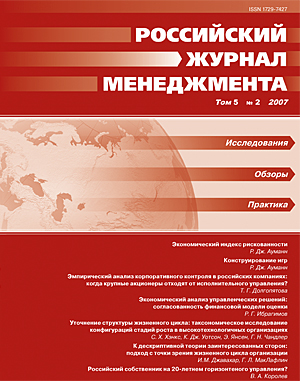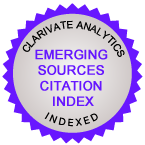Organizational Life-Cycle: Empirical Research and Theoretical Justification
Downloads
Download data is not yet available.
References
ЛИТЕРАТУРА НА РУССКОМ ЯЗЫКЕ
Адизес И. 2006. Как преодолеть кризисы менеджмента: диагностика и решение управленческих проблем. СПб.: Стокгольмская школа экономики в Санкт-Петербурге.
Адизес И. 2007. Управление жизненным циклом корпорации. СПб.: Питер.
Грейнер Л. Е. 2002. Эволюция и революция в процессе роста организаций. Вестник С.-Петербургского ун-та. Сер. Менеджмент (4): 76–92.
Железняк Т. 2001. Какая она, ваша компания? Персонал-Микс (2): 63–71.
Ивашковская И. В., Константинов Г. Н., Филонович С. Р. 2004. Становление корпорации в контексте жизненного цикла организации. Российский журнал менеджмента 2 (4): 19–34.
Кушелевич Е., Филонович С. 2004. Модели жизненных циклов организаций. В сб.: Виханский О. С., Наумова А. И. (ред.). Менеджмент: век ХХ — век ХХI. М.: Экономистъ; 304–321.
Семенков И. 2001. Стадии развития организации. Управление персоналом (9): 62–71.
Филонович С. Р. 2001. Чем болеют компании. Секрет фирмы (11): 56–58.
Широкова Г., Меркурьева И., Серова О. 2006. Особенности формирования жизненных циклов российских компаний (эмпирический анализ). Российский журнал менеджмента 4 (3): 3–26.
REFERENCES IN LATIN ALPHABET
Adizes I. 1989. Corporate Lifecycles: How and Why Corporations Grow and Die and What to Do About It. Prentice Hall: Englewood Cliffs, NJ.
Abernathy W. 1976. Production process, structure and technological change. Decision Science 7 (4): 607–618.
Cameron K., Whetten D., Kim M. 1987. Research notes: Organizational dysfunction of decline. Academy of Management Journal 30 (1): 126–138.
Churchill N., Lewis V. 1983. The five stages of small business growth. Harvard Business Review 61 (3): 30–50.
Cyert R. 1978. The management of universities of constant or decreasing size. Public Administration Review 38 (4): 344–349.
D’Aunno T., Zuckerman H. 1987. A life cycle model of organizational federations: The case of hospitals. Academy of Management Review 12 (3): 259–261.
Dodge H., Fullerton S., Robbins J. 1994. Stage of the organizational life cycle and competition as mediators of problem perception for small businesses. Strategic Management Journal 15 (2): 121–134.
Dodge H. R., Robbins J. E. 1992. An empirical investigation of the organizational life cycle model for small business development and survival. Journal of Small Business Management 30 (1): 27–37.
Downs A. 1967. The life cycle of bureaus. In: Downs A. Inside Bureaucracy. Little, Brown and Company: San Francisco, CA; 296–309.
Drazin R., Kazanjian R. K. 1990. A reanalysis of Miller and Friesen’s life-cycle data. Strategic Management Journal 11 (4): 319–325.
Galbraith J. 1982. The stages of growth. Journal of Business Strategy 3 (1): 70–79.
Gray B., Ariss S. S. 1985. Politics and strategic change across organizational life cycles. Academy of Management Review 10 (4): 707–723.
Grimm C., Smith K. 1997. Strategy As Action: Industry Rivalry and Coordination. West Publishing Co.: St. Paul, MN.
Gupta Y., Chin D. 1992. Organizational life cycle and organizational strategic orientation: An empirical examination. International Journal of Management 3: 215–227.
Gupta Y., Chin D. 1994. Organizational life cycle: A review and proposed directions for research. The Mid-Atlantic Journal of Business 30 (3): 269–294.
Hall R. 1976. A system of pathology of an organization: the rise and fall of the old Saturday evening post. Administrative Science Quarterly 21 (2): 185–221.
Hanks S. H., Watson C. J., Jansen E., Chandler G. N. 1993.Tightening the life-cycle construct: A taxonomic study of growth stage configurations in high-technology organizations. Entrepreneurship Theory and Practice 12 (2): 5–30.
Kazanjian R. K. 1988. Relation of dominant problems to stages of growth in technology-based new ventures. Academy of Management Journal 31 (2): 257–279.
Katz D., Kahn R. L. 1978. The Social Psychology of Organizations. Wiley: N. Y.
Kimberly J. R., Miles R. H. 1980. The Organizational Life Cycle. Jossey-Bass: San Francisco: CA.
Kiriri P. N. 2002. Business Planning: A Typology for Small and Medium Enterprise (SME) Life Cycle Stages. Doctoral Dissertation, Southern Cross University, Lismore.
Lester D., Parnell J. 1999. A strategic interpretation of organizational life cycle. Journal of Applied Management and Entrepreneurship 5 (1): 14–32.
Lester D., Parnell J. 2002. Aligning factors for successful organizational renewal. The Leadership and Organization Development Journal 23 (2): 60–67.
Lester D. L., Parnell J. A., Carraher A. 2003. Organizational life cycle: A five-stage empirical scale. The International Journal of Organizational Analysis 11 (4): 339–354.
Levine C. 1978. Organizational decline and cutback management. Public Administration Review 38 (4): 316–324.
Lodahl T., Mitchell S. 1980. Drift in the development of innovative organizations. In: Kimberly J., Miles R. (eds.). The Organizational Life Cycle. Jossey-Bass: San Francisco, CA; 184–207.
Lyden F. 1975. Using Parsons’ functional analysis in the study of public organizations. Administrative Science Quarterly 20 (1): 59–70.
Masurel E., van Montfort K. 2006. Life cycle characteristics of small professional service firms. Journal of Small Business Management 44 (3): 461–473.
McCurdy H. 1991. Organizational decline: NASA and the life cycle of bureaus. Public Administration Review 51 (4): 308–315.
Miles R., Snow C., Sharfman M. 1993. Industry variety and performance. Strategic Management Journal 14 (3): 163–177.
Miller D., Friesen P. H. 1984. A longitudinal study of the corporate life cycle. Management Science 30 (10): 1161–1183.
Miller D., Shamsie J. 2001. Learning across the life cycle: Experimentation and performance among the Hollywood studio heads. Strategic Management Journal 22 (8): 725–745.
Mintzberg H. 1984. Power and organization life cycles. Academy of Management Review 9 (2): 207–224.
Pettigrew A. 1979. On studying organizational cultures. Administrative Science Quarterly 24 (4): 570–581.
Quinn R. E., Cameron K. 1983. Organizational life cycles and shifting criteria of effectiveness; Some preliminary evidence. Management Science 29 (1): 33–51.
Scanlan B. 1980. Maintaining organizational effectiveness — A prescription for good health. Personnel Journal 59 (5): 381–386.
Scott W. 1976. The management of decline. Conference Board Record (8): 56–59.
Smith K. G., Mitchell T. R., Summer C. E. 1985. Top level management priorities in different stages of the organizational life cycle. Academy of Management Journal 28 (4): 799–820.
Torbert W. R. 1974. Pre-bureaucratic and post-bureaucratic stages of organization development. Interpersonal Development 5 (1): 1–25.
Downloads
Published
2007-09-20
How to Cite
Shirokova, G. V. (2007). Organizational Life-Cycle: Empirical Research and Theoretical Justification. Russian Management Journal, 5(3), 85–90. Retrieved from https://rjm.spbu.ru/article/view/543
Issue
Section
Modern Classics: Organizational Life-Cycle
License
Articles of the Russian Management Journal are open access distributed under the terms of the License Agreement with Saint Petersburg State University, which permits to the authors unrestricted distribution and self-archiving free of charge.





